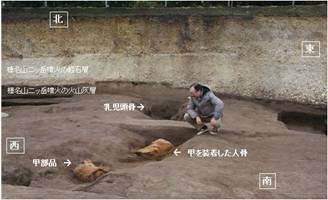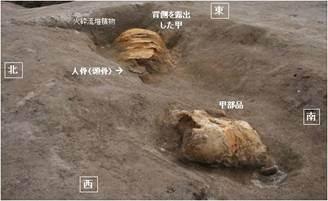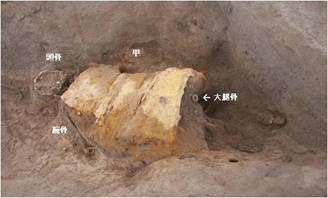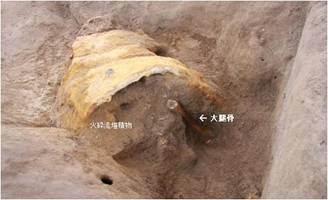Joseph Ryan
Source - http://japanesearchaeology.com/
It was announced on December 10 that the remains of a Kofun-Period infant and adult male were recovered from the Kanai Higashiura site (金井東裏遺跡; Shibukawa city, Gunma prefecture), buried under a layer of volcanic ash dating to the early-6th century (the Late Kofun Period). While sites buried under volcanic ash have been found previously, this marks the first discovery of Kofun-Period human remains in such a context.
The Kanai Higashiura site provides another “first” for Japan, as well — the adult male is wearing a lamellar suit of armor (kozanekō 小札甲 or keikō 挂甲). Over 600 suits of Kofun-Period armor have been discovered to date, but never before had one been found worn by its owner. Previous finds of suits of armor have all been found from tombs, placed next to their owner as one of the many accompanying burial goods.
Numerous iron arrowheads were also found nearby.
Pictures from the site:

Nearest the man is the armor-wearing individual. To the left is separate piece of armor. Above the armor and behind the researcher is the skull of an infant.

Picture top: Armor and human remains; bottom: piece of armor

Picture left: skull; middle: armor; right: femur

Facing the viewer: femur
The Kanai Higashiura site was buried following the eruption of Harunayama Futatsudake (榛名山二ッ岳; Hr-FA) in the early-6th century (it would erupt again in the mid-6th century). Nearby sites Kuroimine (黒井峯遺跡) and Nakasuji (中筋遺跡) were also affected, their levels of preservation prompting researchers to call them “the Pompeii of Japan.”
The adult male was found face down in the direction of Harunayama. Judging by the angle of his legs, researchers believe he fell forward from a kneeling position.
Several pit dwellings (竪穴住居) from the late-5th century have been found in the area, in addition to the nearby Maruyama Kofun (丸山古墳) and numerous tombs along the Tone River (利根川).
The fact that lamellar armor belonged almost exclusively to the elite in this period gives us a generous clue as we attempt to reconstruct the local history of the region and understand the level of administrative and military control exercised by the central Yamato authorities.
Ichinose Kazuo (一瀬和夫) of Kyoto Tachibana University suggests that the man was perhaps a guard of an elite residence. The fact that he is not wearing a full suit of armor (only protection for his torso and thighs) may imply that he was not on official duty, but rather running for cover with his family. Others, citing the size and nature of tombs bearing similar armor, however, believe the man to have been a local ruler of sorts.